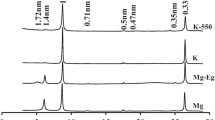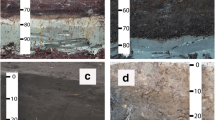Abstract
Weathering of abraded metallic Pb from bullets is a significant source of Pb contamination in shooting range soils. Weathering studies were performed using metallic Pb powder to simulate the fine-size fraction of metallic Pb found in shooting range soils. The effects of soil properties (moisture, organic matter-[OM] and pH) on weathering of abraded metallic Pb were examined by incubating a typical Florida soil for 5 to 12 days at 100% or 80% field capacity (FC) after spiking with 5% metallic Pb, after removal of soil OM at 100% FC, and after adjusting the soil pH to 4.8, 6.1 or 8.5 at 100% FC. The weathering products were examined using X-ray diffraction (XRD). Transformation of metallic Pb to secondary Pb-minerals was more rapid at 100% FC, in the presence of OM, and at lower pH. While little transformation of Pb occurred in the absence of soil OM and mostly litharge (PbO) was found at higher pH, both hydrocerussite and litharge formed at lower pH. A three-step weathering mechanisms of metallic Pb including oxidation, carbonation and dissolution was proposed. Addition of both calcium carbonate and phosphate rock was effective in reducing water-soluble Pb, though the effect was minimal after 11 weeks of incubation, attributing to the liming effect of metallic Pb added to the soil. While reducing soil moisture and organic matter and increasing soil pH slowed weathering of metallic Pb in a soil, the effect of calcium carbonate and phosphate rock on Pb solubility in soils highly contaminated with Pb was limited.
Similar content being viewed by others
References
Astrup, T., Boddum, J. K., & Christensen T. H. (1999). Lead distribution and mobility in a soil embankment used as a bullet stop at a shooting range. Journal of Soil Contamination, 8, 653–665.
Brady, N. C., & Weil, R. R. (2000). Elements of the nature and properties of soils. Upper Saddle River, New Jersey: Prentice-Hall.
Brown, G. E., Foster, A. L., & Ostergren, J. D. (1999). Mineral surfaces and bioavailability of heavy metals: A molecular-scale perspective. Proceedings of the National Academy of Sciences, 96, 3388–3395.
Cao, X., Ma, L. Q., Chen, M., Singh, S. P., & Harris, W. G. (2002). Impacts of phosphate amendments on lead biogeochemistry at a contaminated site. Environmental Science & Technology, 36, 5296–5304.
Cao, X., Ma, L. Q., Hardison Jr., D. W., & Harris, W. G. (2003a). Weathering of lead bullets and their environmental effects at outdoor shooting ranges. Journal of Environmental Quality, 32, 526–534.
Cao, X., Ma, L. Q., Chen, M., Hardison Jr., D. W., & Harris, W. G. (2003b). Lead transformation and distribution in the soils of shooting ranges in Florida, USA. Science of the Total Environment, 307, 179–189.
Chen, M., Ma, L. Q., & Harris, W. G. (2001). Distribution of Pb and As in soils at a shooting facility in Central Florida. Soil Crop Science Society Florida Proc., 60, 15–20.
Craig, J. R., Rimstidt, J. D., Bonnaffon, C. A., Collins, T. K., & Scanlon, P. F. (1999). Surface water transport of lead at a shooting range. Bulletin of Environmental Contamination and Toxicology, 63, 312–319.
Edwards, R., Bordass, W., & Farrell, D. (1997). Determination of acetic and formic acid in lead corrosion products by ion-exchange chromatography. Analyst, 122, 1517–1520.
Gee, G., Ramsey, M., & Thornton, I. (2001). Buffering from secondary minerals as a migration limiting factor in lead polluted soils at historical smelting sites. Applied Geochemistry, 16, 1193–1199.
Geebelen, W., VanGronsveld, J., Adriano, D. C., Carleer, R., & Clijsters, H. (2002). Amendment-induced immobilization of lead in a lead-spiked soil: Evidence from phytotoxicity studies. Water Air Soil Pollution, 140, 261–277.
Graedel, T. E. (1994). Chemical mechanisms for the atmospheric corrosion of lead. Journal of the Electrochemical Society, 141, 922–927.
Hardison Jr., D. W., Ma, L. Q., Luongo, T., & Harris, W. G. (2004). Lead contamination in shooting range soils from abrasion of lead bullets and subsequent weathering. Science of the Total Environment, 328, 175–183.
Hettiarachchi, G. M., Pierzynski, G. M., & Ransom, M. D. (2001). In situ stabilization of soil lead using phosphorus. Journal of Environmental Quality, 30, 1214–1221.
Jorgensen, S. S., & Willems, M. (1987). The fate of lead in soils: The transformation of lead pellets in shooting range soils. Ambio, 16, 11–15.
Kunze, G. W., & Dixon, J. B. (1986). Pretreatment for mineralogical analysis: Removal of organic matter. In A. Klute (Ed.), Methods of soil analysis. Part 1. Physical and mineralogical methods, Vol. 9, 2nd ed. (pp. 95–97). Madison, Wisconsin: ASA, SSSA.
Lin, Z. (1996). Secondary mineral phases of metallic lead in soils of shooting ranges from Orebro County. Sweden Environmental Geology, 27, 370–375.
Lin, Z., Comet, B., Qvarfort, U., & Herbert, R. (1995). The chemical and mineralogical behavior of Pb in shooting range soils from Central Sweden. Environmental Pollution, 89, 303–309.
Luo, Y., & Hong, A. (1997). Oxidation and dissolution of lead in chlorinated drinking water. Advances Environmental Res, 1, 84–97.
Ma, L. Q., & Rao, G. N. (1997). Effects of phosphate rock on sequential chemical extraction of lead in contaminated soils. Journal of Environmental Quality, 26, 788–794.
Ma, L. Q., & Rao, G. N. (1999). Aqueous Pb reduction in Pb-contaminated soils by Florida Phosphate Rocks. Water Air Soil Pollution, 110, 1–16.
Ma, L. Q., Logan, T. J., & Traina, S. J. (1995). Lead immobilization from aqueous solutions and contaminated soils using phosphate rocks. Environ. Sci. Technol, 29, 1118–1126.
Maskall, J. E., & Thornton, I. (1998). Chemical partitioning of heavy metals in soils, clays and rocks at historical lead smelting sites. Water Air Soil Pollution, 108, 391–409.
Murray, K., Bazzi, A., Carter, C., Ehlert, A., Harris, A., Kopec, M. et al. (1997). Distribution and mobility of lead in soils at an outdoor shooting range. Journal of Soil Contamination, 6, 79–93.
Nelson, D. W., & Sommers, L. E. (1982). Total carbon, organic carbon, and organic matter. In A. L. Page, R. H. Miller, & D. R. Keeney (Eds.), Methods of soil analysis. Part 2. Chemical and microbiological properties, Vol. 9, 2nd ed. (pp. 539–577). Madison, Wisconsin: ASA.
Nriagu, J. O. (1974). Lead orthophosphates-IV formation and stability in the environment. Geochim. Cosmo. Acta, 38, 887–898.
Olsen, S.R., Sommers, L. E. (1982). Phosphorus. In: A. L. Page, R. H. Miller, & D. R. Keene (Eds.), Methods of Soil Analysis. Part 2. Chemical and Microbiological properties, Vol. 9, (pp. 403–427). Madison, Wisconsin: ASA.
Pourbaix, M. (1966). Corrosion. In M. Pourbaix (Ed.), Atlas of electrochemical equilibria in aqueous solutions (pp. 70–83). Oxford: Pergamon.
Rocca, E., & Steinmetz, J. (2001). Inhibition of lead corrosion with saturated linear aliphatic chain monocarboxylates of sodium. Corrosion Science, 43, 891–902.
Scheuhammer, A. M., & Norris, S. L. (1995). A review of the environmental impacts of lead shotshell ammunition and lead fishing weights in Canada 88. Minister of Environment Canadian Wildlife Service, Ottawa, Ontario.
Traina, S. J., & Laperche, V. (1999). Contaminant bioavailability in soils, sediments, and aquatic environments. Proceedings of the National Academy of Sciences, 96, 3365–3371.
Turpeinen, R., Salminen, J., & Kairesalo, T. (2000). Mobility and bioavailability of lead in contaminated Boreal forest soil. Environmental Science & Technology, 34, 5152–5156.
US Environmental Protection Agency (USEPA) (2001). EPA-902-B01-001: Best Management Practices for Lead at Outdoor Shooting Ranges. United States Environmental Protection Agency Region 2.
Zimdahl, R. L., & Skogerboe, R. K. (1977). Behavior of lead in soil. Environmental Science & Technology, 11, 1202–1206.
Author information
Authors and Affiliations
Corresponding author
Rights and permissions
About this article
Cite this article
Ma, L.Q., Hardison, D.W., Harris, W.G. et al. Effects of Soil Property and Soil Amendment on Weathering of Abraded Metallic Pb in Shooting Ranges. Water Air Soil Pollut 178, 297–307 (2007). https://doi.org/10.1007/s11270-006-9198-7
Received:
Accepted:
Published:
Issue Date:
DOI: https://doi.org/10.1007/s11270-006-9198-7




